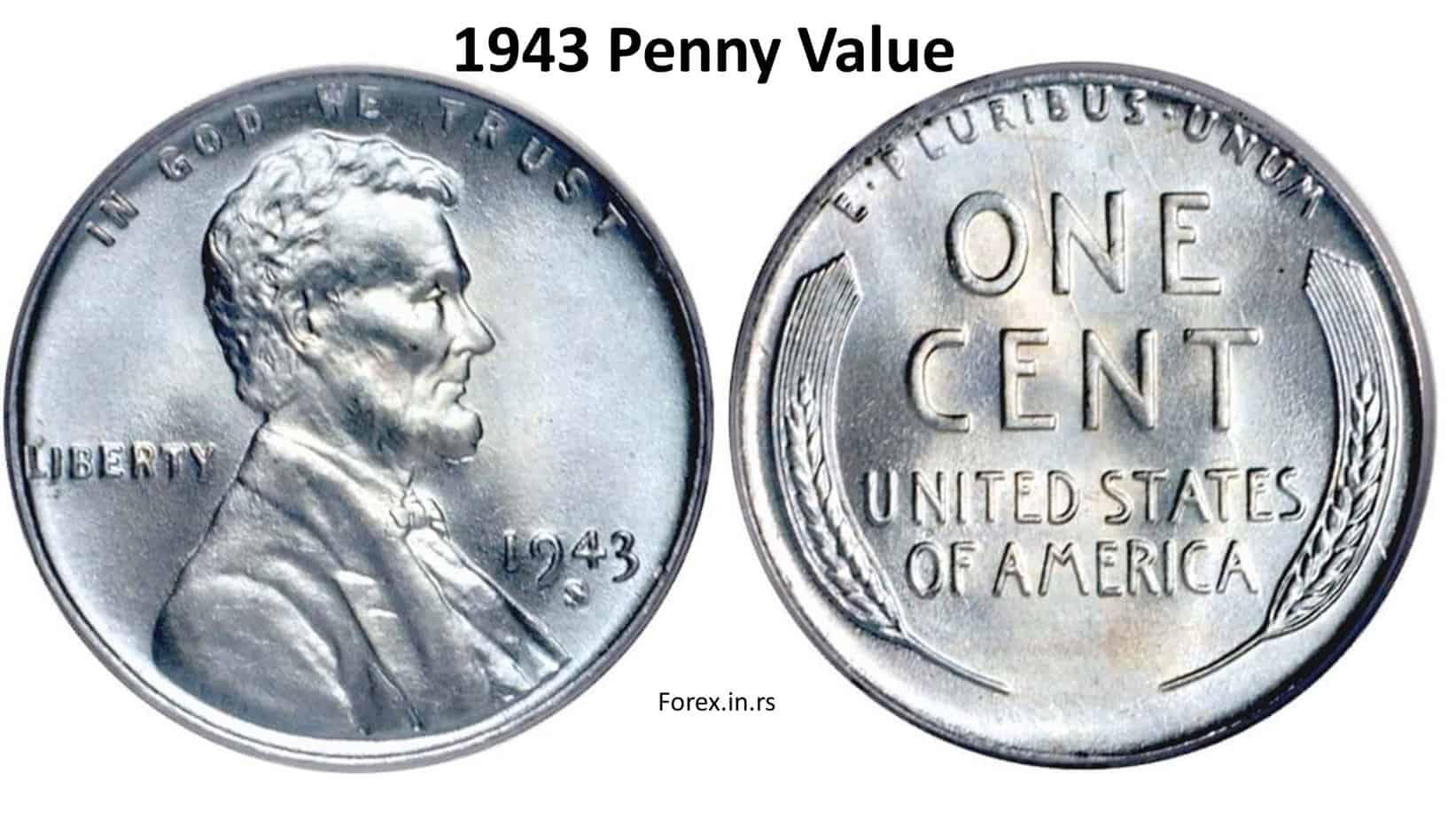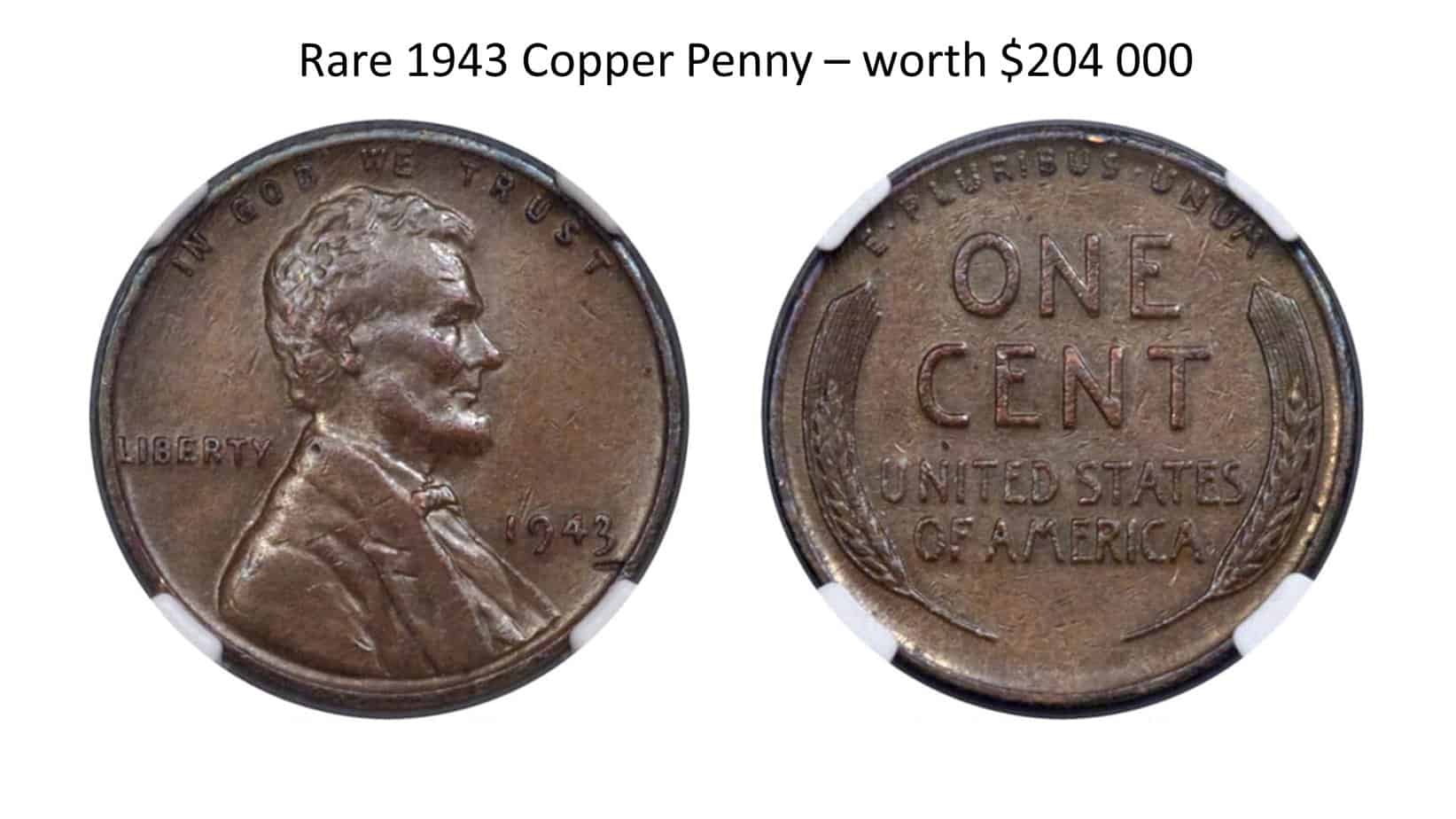1943 introduced one of the most iconic coins in American history—the Lincoln Wheat Penny. Featuring an image of Abraham Lincoln on one side and two stalks of wheat on the other, the coin is instantly recognizable among collectors and non-collectors alike.
The 1943 penny is minted from a zinc-coated steel composition due to shortages caused by World War II. This makes it distinguishable from other pennies, which are typically made from a bronze alloy. It measures 19 millimeters in diameter, with a reeded edge and a raised rim around its circumference. Its weight is 3.11 grams—slightly less than those made with the standard bronze alloy, which weighs 3.11 grams each.

On its obverse side, the coin features an image of President Abraham Lincoln designed by Victor D Brenner in 1909 for the centenary celebration of his birth; “LIBERTY” appears above his head in capital letters, while “IN GOD WE TRUST” appears around him on a scroll at the bottom. The reverse shows two stalks of wheat with the denomination “ONE CENT” at their center along with their motto: “UNITED STATES OF AMERICA” around them at the top and “E PLURIBUS UNUM” at their base; this phrase is Latin for ‘out of many, one.’
In addition to being rarer than other pennies minted during this period (for example, only 1% of all 1942 pennies were produced in steel), 1943 wheat pennies are also valuable due to their age and condition. Coins rated as uncirculated can fetch up to $6 or more depending on their coloration and luster—which may range from bright copper to reddish-brown or steel gray—while well-worn pieces may be worth only 10 cents to 25 cents each because they are more widely available.
Collectors seeking an original 1943 wheat penny should be aware that there have been many counterfeits circulating over the years since then; these fakes can typically be identified by signs such as incorrect lettering or off-center images depicting Lincoln’s face or wheat stalks. Simple examples can be found through reputable coin dealers or auction sites like eBay, but buyers should always exercise caution when acquiring valuable coins online.
The 1943 penny is undoubtedly one of America’s most beloved coins for its historical significance and aesthetic value; it continues to captivate coin enthusiasts worldwide even seven decades after its creation!
The 1943 penny is a valuable coin, and many people search for it when looking for rare and collectible coins. The U.S. Mint minted fewer pennies in 1943 than in other years due to wartime shortages of copper and zinc, the two metals used in making the penny. This makes the 1943 penny rare, with some collectors willing to pay top dollar.
How Much is a 1943 Penny Worth?
1943 Zinc penny is worth from $0.1 to $2 as an uncirculated coin on average. The 1943 D Zinc value is from $0.2 up to $3. Uncirculated 1943-S Zinc is worth up to $6. However, the steel 1943 penny can be worth up to $450 (Mint-State 63), while the record price for a 1943 copper penny was over $1.7 million at auction in 2010.
Below, you can see the 1943 value Table:
| 1943 Coin Grade | Grade symbol | 1943 penny worth |
|---|---|---|
| Good | (G-4) | $0.1 |
| Very Good | (VG-8) | $0.15 |
| Fine | (F-12) | $0.2 |
| Very Fine | (VF-20) | $0.25 |
| Extremely Fine | (EF-40) | $0.4 |
| About Uncirculated | (AU-50) | $4 |
| Uncirculated | (MS-60) | $1.6 |
| Uncirculated 1943-S Zinc | (MS-63) | $6 |
| 1943 Copper Lincoln penny | from $10 000 and more |
In general, the value of a 1943 penny depends on its condition. Good grade, which refers to lightly circulated pennies with minimal wear and tears, can be worth up to $0.20. The value increases from good to excellent, where a penny can fetch up to $1 or more depending on its condition. This means an uncirculated 1943 penny—a specimen that never went into circulation—can be worth up to $5 or more!
That said, it’s important to note that not all 1943 pennies are valuable. There were three different versions of the coin produced in that year: steel cents (made from recycled steel during World War II), zinc-coated steel cents (created after the war), and bronze cents (the common issue). Steel cents are common and generally only worth face value, while zinc-coated steel cents may command slightly higher prices depending on their condition; these usually have small amounts of copper plating added when they were produced in 1945 and later years. Collectors much more highly value bronze cents since they’re rarer than either type of steel cent; these usually feature notable details such as wheat stalks on their reverse side.
Before you put too much stock into your coin’s price tag, consider having it authenticated by an expert coin grader first; fakes abound, so it pays to know what’s real before investing any money in a purchase or sale! Established coins then have one of several grading scales assigned to them based on factors such as luster, scratches, and overall eye appeal; this will determine their value more accurately than anything else can. As far as authenticity is concerned, always buy coins from reputable dealers who offer lifetime guarantees on their products if you’re looking for collector pieces!
Rare 1943 Copper Penny
As I wrote recently about the rare 1964 penny value, there is another attractive rare coin, the 1943 copper coin.
For numismatics enthusiasts, the recent sale at the Florida United Numismatics convention in Orlando, Florida, was an exciting event. On offer was a rare 1943 copper penny that was part of the collection of collector Elden Lutes. After an intense bidding war, the prized possession fetched a great price – $204,000.

The coin is one of fewer than 20 known to exist and is considered one of the most valuable pieces of American currency. It is believed to have been struck by mistake, as all other 1943 pennies were made out of zinc-coated steel due to a shortage of copper during World War II.
The coin first entered circulation when 10-year-old Don Lutes Jr., from Pittsfield, Massachusetts, found it amongst the change he had received from his lunch at school. He kept it for years before showing it off to coin dealers and collectors, who told him it was a rare and valuable coin. In 1958, Lutes sold it to prominent numismatist and dealer Abe Kosoff for several hundred dollars — a price that would seem almost laughably small compared to what the auctioned specimen went for sixty years later in 2019.
Two bidders vied for the historical item at the auction: Heritage Auctions bidder Mark Borckardt and another anonymous bidder via telephone. The latter eventually won out, setting a record sale price for any regular issue U.S. copper cent ever sold at public auction, according to heritage auctions director Laura Sperber, who said she had “never seen anything like it” as “the bidders just kept going up” with no signs of slowing down until the gavel finally fell on $204,000.
This particular piece has gained notoriety over the years, even being featured in TV shows such as Pawn Stars and Antiques Roadshow; however, it is not known if this particular example is the same one shown in those programs or even if this is, indeed Don Lutes Jr.’s original specimen that he kept all these years after finding it in his lunch money change decades ago.
No matter its history or origin story, this rare piece fetched quite a pretty penny come auction day – more than double its estimated value – reaffirming its status as one of America’s most iconic coins and allowing its new owner to gain much satisfaction from such an incredible find hopefully!
Conclusion
Overall, while 1943 pennies aren’t necessarily rare enough (or expensive enough) to attract serious numismatists like those chasing after 1933 Saint Gaudens Double Eagles or 1804 Silver Dollars, they nonetheless remain popular items among coin collectors due primarily to their scarcity relative to other years’ mintage figures—making them ideal investments for those looking for things that will hold onto their monetary value over time!
























